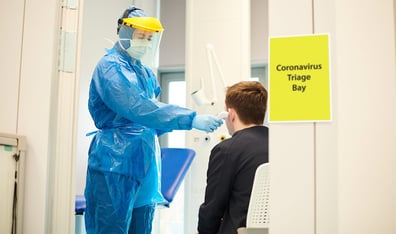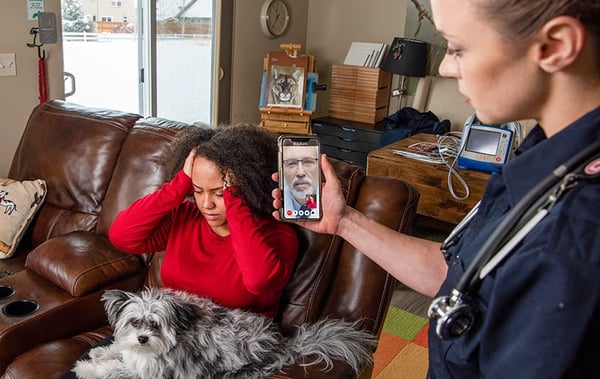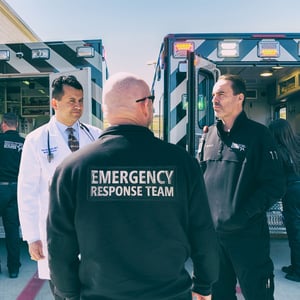Pulsara Around the World - 2025 Recap and January 2026
December Recap After an incredibly busy events year with 102 conferences, trade shows, and sponsorships, December was on the slower side for us, with...
6 min read
 Team Pulsara
:
Aug 31, 2020
Team Pulsara
:
Aug 31, 2020
![How Current Events Will Shape the Future of EMS [2020 EMS Trend Report Part 2]](https://www.pulsara.com/hubfs/ambulance-street-1200x630.jpg)
EDITOR'S UPDATE: The ET3 program is mentioned in the article below. Please note that, as reported by JEMS.com on 6/28/23, the federal government is ending the ET3 program. According to the Centers for Medicare & Medicaid Services, “This decision does not affect Model Participants’ participation in the Model through December 31, 2023.” Read the full article on JEMS for more details: ET3 Program Comes to an Abrupt End. Be advised that Mobile Integrated Healthcare and Community Paramedicine are separate initiatives and are unaffected by the ET3 program termination.
EDITOR'S NOTE: Last month, EMS1, Fitch & Associates, and the National EMS Management Association released their third annual EMS Trend Report, proudly sponsored by Pulsara. Because the articles and advice found within contain such critical subject matter, we've elected to publish each segment one at a time here on our blog. Read, enjoy, share, and take to heart the following information brought to you by the most prestigious thought leaders in EMS.
About the Author: Rob Lawrence is the principal of Robert Lawrence Consulting. He previously served as the chief operating officer of Paramedics Plus in Alameda County, California. Before that, Rob was the COO of the Richmond Ambulance Authority. Rob is a former board member of the American Ambulance Association and currently serves as chair of its Communications Committee and a member of the media rapid response task force.
This data for this year’s EMS Trend Report was collected in 2019 B.C. – before COVID-19. At the time, we didn’t know what was just round the corner. This year’s report provides a real indicator of the circumstances and challenges we have already seen in the COVID-19 era. As EMS staff were the first warriors into the battle and onto the front line, mental health, post-traumatic stress injury and burnout have elevated to the top of the chart.
Money is also becoming too tight to mention. The reduction in call and transport volume has reduced income, which has led to a reduction in hours, cancellation of overtime, and ultimately layoffs and furloughs. As we return to the new normal, volumes are showing an increase, but the financial pain remains. With 15% of the entire population now out of work, a precipitous fall in health insurance will follow, which will continue to place a significant strain on organizational budgets.
In addition, civil unrest has added another stressor and response challenge as tensions spread through many cities and communities.
Based on what we’ve gleaned from the 2020 EMS Trend Report data, we can envision how current events will shape EMS, and what leaders can do to overcome the challenges ahead.
 The nation is eagerly awaiting a COVID-19 vaccine, but those of us in healthcare know that there are stages and phases to rollout that require trials and testing. This is not a brief process, and even when the right vaccine is found, manufacturing, distribution and administration of 320 million doses is going to take time. EMS is going to remain on the front lines for a considerable time, and most probably will experience a case of first in and last out. Against this scenario, we must ensure that EMS workers are high on the priority for early immunization and – for peace of mind – their families as well. This would not only be a great public health and risk reduction measure, but also a great morale boost.
The nation is eagerly awaiting a COVID-19 vaccine, but those of us in healthcare know that there are stages and phases to rollout that require trials and testing. This is not a brief process, and even when the right vaccine is found, manufacturing, distribution and administration of 320 million doses is going to take time. EMS is going to remain on the front lines for a considerable time, and most probably will experience a case of first in and last out. Against this scenario, we must ensure that EMS workers are high on the priority for early immunization and – for peace of mind – their families as well. This would not only be a great public health and risk reduction measure, but also a great morale boost.
As all in EMS settle into this ultra-marathon, agencies must ensure that their most important asset – their staff – are cared for. That care begins with ensuring their working conditions and environment are the best they can be, given the circumstances. This includes having sufficient PPE and decontamination equipment to ensure operational peace of mind. In addition to having sufficient tools to do the job, pastoral care must be high on the priority list, ensuring mental health, stress reduction, and emotional wellness are all addressed. The former requires good management; the latter, great leadership.
EMS has been operating at high tempo in COVID-19 hotspots and latterly, civil unrest flash points. The nation’s emotions are running high, but EMS is doing what it does best – treating our fellow human beings with empathy, compassion, and professionalism. EMS does not take a side; it never has, whether it is treating the shooting victim or the shooter, a patient in a vehicle accident or the impaired driver that caused it. We care, and must continue to care. Without doubt, the increased intensity is contributing to provider burnout (38% of respondents reported symptoms of burnout, including physical, emotional, or mental exhaustion).

As we move into the future, we must also be aware of our own diversity. The recently published EMS Assessment 2020 identified that only a small number of states could identify the ethnic demographics of our industry. The small section that did respond identified a less-than-diverse representation of the workforce. Here we must do better to both identify who we are and thereafter work to ensure that our workforce reflects the communities we serve.
The recently issued NASEMSO statement on racial bias and unity announced the organization’s commitment to eliminate racism and promote racial equality. The statement noted, “We must ensure that each facet of the emergency medical system is inclusive, informed, and committed to end racial inequality and racism. We must identify any biases within ourselves and have the courage and empathy to fully commit our platform and resources to create an inclusive, diverse society with the cornerstone of equality for all.” We must eliminate any biases we have in dealing with any patient, anywhere, and at any time. We must also work to ensure that we provide an equity of coverage within the operating areas in which we serve.
If a system does not provide an equitable all-encompassing service, then it must be adjusted immediately to do so. A well-documented historical EMS example is the creation of the Richmond Ambulance Authority. Prior to 1990, several for-profit ambulance services operated in the city of Richmond, Virginia, and their combined response focus saw them all essentially racing each other to insured, paying patients. This resulted in a biased level of service that left the lower socio-economic areas of the city virtually uncovered. Against that backdrop, the city created the RAA as a public utility model (PUM) to serve all equitably, regardless of the patient’s ability to pay or insurance coverage. Since then, RAA has gained national and international recognition for its approach to EMS as a mobile integrated healthcare provider.
Reimbursement has a place in this year’s response, and is an ongoing EMS challenge. Reimbursement is an essential element of the EMS circle of financial life. No income equals zero solvency or non-existent financial balance. Reimbursement not only means the physical act of reclaiming payment from insurance companies or Medicare, but also fighting the legislative battle to ensure that government rates covers the cost of readiness and, therefore, overall EMS delivery.
In 2020 and beyond, the entire EMS industry and its myriad of associations must come together to advocate for reimbursement and provider benefits. The only way forward is to act with one voice, so our elected officials receive one, solid, consistent message.

Similarly, the industry disruption caused by COVID-19 has seen EMS systems provide treat-in-place services to save the capacity of emergency departments. This has been laudable, but under current reimbursement rules, has been a massive loss leader, and no income has been received for this important service rendered. This essential task is also a key component of the ET3 program, and we must now push to ensure we receive the appropriate fee for service.
Another intention of ET3 was to increase the use of telemedicine, and in the last few months, CMS waivers have allowed its increased use and the ET3 the concept has already proven its worth. We all hope that once the declared pandemic emergency ends, we do not have to take retrospective steps as current waivers are withdrawn.
Recruiting and retention continues to be a major issue for non-fire-based EMS services and systems. Recruiting and retention tends to be a vicious circle, as it takes 3-4 months to advertise, recruit, induct and clear a new employee to operate on the street, and can take just one day to lose an employee. This means organizations are always on the back foot when it comes to having the appropriate numbers of staff, and are always having to recruit.

This cycle demands significant time, effort, and funding into keeping staffing levels up. The antidote is simply to reduce staff attrition by improving perceived terms and conditions for the workforce, and increase retention. Constant HR and staffing needs require significant funding, but imagine if a similar amount of budget was placed into retention initiatives? Whether it is an increase to the hourly rate, enhanced medical coverage, or long service bonus programs, the same amount spent on finding new people could be invested in current – and therefore more experienced and productive – staff.
A major retention issue also plagues rural areas. The traditional model of volunteer fire departments and ambulance squads providing coverage on a 24/7 basis is declining to the point of closure. The solution has been to establish combination agencies, where the volunteers fill the evenings and weekends as they are available and paid providers are brought in to staff the day shift. This model could well be an unfunded mandate to local governing bodies as they have never had to finance their first response to a major extent. Now they must dig deep into a coffer that has also shrunk because of COVID-19.
The second rural danger also lies in reimbursement. Rural EMS usually equates to large or challenging geography and a dispersed population. The cost of readiness, in this case, equates to widely dispersed units to deal with a low call volume. This drives the overall cost per call to an unaffordable sum and has led some areas to lose their coverage as providers pull out because their business models do not allow such loss leaders.

Rural versus urban also comes into focus when examining paramedic availability and certification. The EMS Trend Report observes better availability in urban areas than rural. This supports a statement frequently made by NAEMT President, Matt Zavadsky who has said, “We don’t have a paramedic shortage, we have a paramedic mal-distribution.”
It has often been said in years past that EMS is at a crossroads. While COVID-19 has created challenges for all, there is also an opportunity to pass through the intersection and hit the open road. But this will take cooperation, collaboration, and above all, care – not only for our patients, but our precious staff as well.
Download the full 2020 EMS Trend Report here.
For the latest stats on the state of the EMS profession in 2020, check out part 1, part 3, part 4, and part 5 of our 2020 EMS Trend Report coverage.

December Recap After an incredibly busy events year with 102 conferences, trade shows, and sponsorships, December was on the slower side for us, with...

Editor's Note: In July 2025, EMS1 and Fitch & Associates released their annual EMS trend survey, What Paramedics Want, proudly sponsored by Pulsara....
![[PRESS RELEASE] Published Research Finds Up to 31% Faster STEMI Treatment Times in Rural Hospital Setting with Pulsara](https://www.pulsara.com/hubfs/_1_website-page-blog-assets/pulsara-hosp-teams-assign-cardio-stemi-rn-1200x701.jpg)
Published research shows how using Pulsara, alongside standardized field activation and a focus on stakeholder relationships, improves STEMI care and...